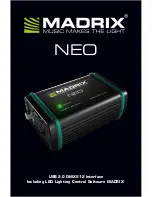
®
M o d e l N o . A P - 8 2 1 4
D a ta A n a l y s i s
7
d.
When you have finished collecting data, click Stop. (If you reach the
maximum force, DataStudio will stop automatically.) If the coupon breaks, it
should break in the middle. If the coupon breaks near the end, it was
probably twisted slightly when you mounted it, resulting in a point of higher
stress where it broke.
4.
Rename the data run to identify the coupon
. Use the same method you used to
rename the calibration data.
Data Analysis
On the Stress versus Strain graph, you can identify features such as the elastic region,
the plastic region, the yield point, and the break point.
To calculate Young's modulus, drag the mouse to select a data region covering the lin-
ear, lower left-hand part of the graph. (You may find that the very first part of the plot
is not linear. This nonlinearity is likely due to the straightening of bends and twists in
the coupon as force is first applied. Do not include this region in your selection.)
Click the Fit button to apply a linear curve fit to the selected data. The slope of the
line is Young's modulus in units of MPa (or MN/m2 or N/mm2).
Notes on the DataStudio Setup File
•
For comparison of different materials, you can collect additional data runs with
other coupons. Note that the Stress calculation applies only to coupons of the
thickness that you entered in the Calculator window. It is easiest to compare cou-
pons of the same thickness. However, to simultaneously display stress versus
strain plots for coupons of different thicknesses, you must create a separate Stress
calculation for each thickness. Copy the existing Stress calculation exactly
(including the calculation properties), but give it a unique name (indicating the
thickness for which it is designed) and enter the applicable cross-section area for
the Area constant.
•
When you create a new Stress calculation, note that there are two different calcu-
lations for Coupon Force- “Coupon Force(F)” and “Coupon Force(t)”. Always
use Coupon Force(F). The “(F)” identifies data as a function of Force, and “(t)”
as a function of time. DataStudio records data as a function of time, but this
experiment requires data to be recast as a function of Force. Whenever you create
a new calculation or graph, be certain to use only data that is a function of Force.
•
When you add a new Stress calculation to the graph, it will initially appear with
time on the horizontal axis. Click the word “time” and select Strain instead.


























